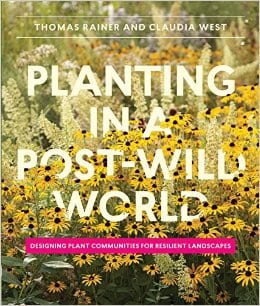 Written by Thomas Rainer and Claudia West
Written by Thomas Rainer and Claudia West
Published by Timber Press, 2015
Reviewed by Penny Lewis
Few books have the power to inspire your design sense, ignite your plant passion, and resonate with your ecological moral compass. Planting in a Post-Wild World is such a book. Two leading figures in ecological landscape design, Thomas Rainer and Claudia West, have come together to offer a bold new way of designing and creating landscapes that are ecological as well as beautiful.
The authors lead the reader into this “post-wild” journey by reflecting upon the taming of the landscape, which eliminated truly wild landscapes from all but the most remote sites, and poignantly pointing out, “…in this light, the recent rally around native plants bears a bit of irony. The belated rediscovery of the virtues of native plants comes at the moment of their definitive decline in the wild.”
At the outset, the case is made that traditional landscape designs can benefit from greater ecological function. Rainer and West urge readers to study and understand the difference between the way plants grow in the wild and in designed gardens. The key to more successful design is a community of compatible species that cover the ground in interlocking layers, the authors refer to this as designed plant communities. These designed plant communities are intended to mimic native plant communities or the naturally occurring “weed patches” that create spontaneous plant communities on disturbed sites.
An underlying element of this design process is the premise that designs must be aesthetically pleasing in addition to ecologically functional. To this end, Rainer and West advise that effective designs need not be restricted to native plants exclusively. They guide the reader to start with a native plant palette but not feel constrained to stop there because “…the concept of designed plant communities is entirely agnostic about where the plants come from.”
After laying out the foundation, the book details the steps for developing designed plant communities in four chapters: Principles of Designed Plant Communities, The Inspiration of the Wild, The Design Process, and Creating and Managing a Plant Community. And while these designed plant communities might provide many ecological services, the authors take care to explain that designed plant communities represent a hybrid of horticulture and ecology – they are not ecological restoration and are unlikely to replicate all of the dynamics of a natural ecosystem that has resulted over time and natural selection.
There are valuable lessons presented throughout by Rainer and West including: the critical nature of plant competitive strategies in a designed plant community; novel approaches to designing with layers to maximize ecological function; and essential principles of related populations, stress as an asset, and the benefits of plant density. There is a wealth of practical information for each of the principles presented, but for me one tip lingered long after reading: “In many ways, the shift from maintenance to management is an affirmation that design does not happen solely during the initial act of creation…. Because designed plant communities are dynamic, management works with a range of natural processes such as competition, succession, and disturbance. Plants that die are not necessarily replaced, but new ones are allowed to fill the gap.”
In contrast to strictly conventional landscape design that prioritizes the relationship of plants to people, or ecological design that emphasizes the relationship of plant to place, the authors place equal weight on these relationships in conjunction with the relationship of plants to other plants. “It is a plant’s relationship with its botanical companions that gives a garden its potency.”
The authors believe that the process of creating designed plant communities can be taught but emphasize that there are no shortcuts. There are no “rigid recipes, cookie-cutter plant lists, or stylistic dictates” in the book. The authors explain that success is only achieved by understanding the site, developing a palette of appropriate plants, and proper installation and management. Throughout the book, direction is provided to guide the reader through the process with many photos, sample design drawings, and detailed narrative. And while some familiar landscape design ideas appear in the book, they are interspersed with concepts that challenge and inspire.
In the summary section, the authors ask the compelling question: Why Designed Plant Communities? Why now? Their conclusions are persuasive. “As populations expand and resources become increasingly limited, plantings can no longer be just ornamental backdrops for our buildings. They must instead perform double duty: cleaning our storm water, providing a food source for pollinators, and acting as a kind of genetic reservoir for diversity. Achieving this requires understanding how plants fit together, how they change over time, and how they form stable compositions.”
The innovative approach to landscape design presented in Planting in a Post-Wild World has been carefully researched, thoughtfully developed, and comprehensively described. For designers who are committed to ecological principles, this book offers both the inspiration and the practical steps necessary to be transformative. This valuable resource is one to read and enjoy – and read again.

